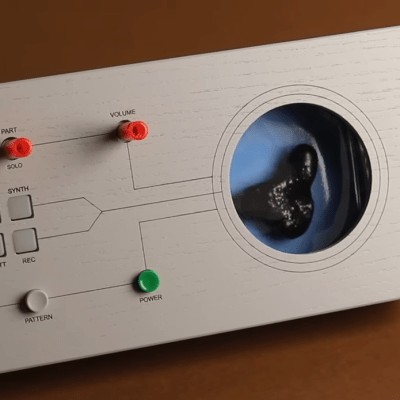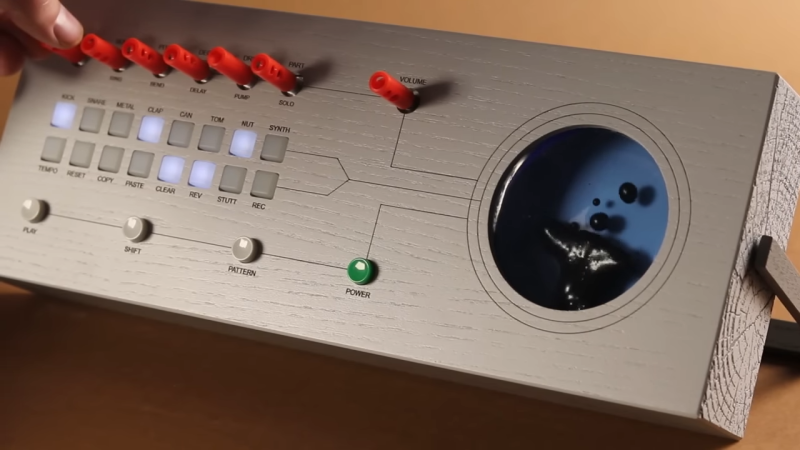[Love Hultén]’s work often incorporates reactive sound elements, and his Ferrofluid drum synth is no exception. Sadly there are no real build details but have no fear: we’ve gathered plenty of DIY insights when it comes to ferrofluid-based projects.

First of all, ferrofluid is shockingly expensive stuff. But if you can get your hands on some old VHS tapes and acetone, you can make your own. Second, working with ferrofluid to make reactive elements is harder than it may look. Particularly, making the stuff dance to sound beats isn’t as simple as putting a container of the stuff in front of a speaker coil, but people have discovered a few ways that work more reliably than others.
[Love Hultén]’s drum synth was inspired by this custom Bluetooth speaker with dancing ferrofluid by [Dakd Jung], which drives an electromagnetic coil with frequencies selected from the audio with an MSGEQ7 equalizer. That way, only frequencies that work best for moving the fluid in interesting ways get used for the visualization. The MSGEQ7 spectrum analyzer chip is very useful for music-driven projects, as demonstrated by these sound-reactive LED shades which illustrate the audio element nicely.
The coils that create the electromagnetic field causing ferrofluid to move can take different forms, but two very interesting ones are this 12-layer PCB coil and for more intricate displays, there’s a 12×21 coil array that creates a dot-matrix-like display.
We have one last tip to share about enclosures. Some readers may have noticed that this drum synth project is housed in what looks like a piece of painted lumber. Wood is certainly a versatile material for making custom shapes, and for lettering and labels it turns out that toner transfer works just as well on wood as it does for making custom PCBs.

















Until I see the guts, I’m assuming that’s 3d animated. It just looks too cool
Ha! I couldn’t help but think the same thing. It almost looks too cool to be real!
It’s real. Saw a video of someone that showed the step-by-step maybe a year or two ago.
It’s all electromagnets and current, lots of it. I don’t expect it to be portable unless built with a big ass battery.
It will very likely be even more spectacular if built into a synthesizer, with oscillators driving different parts of the fluid and the effects obtained by slightly detuning or filtering them, etc.
Sorta like oscilloscope music, but solid and 3D. https://www.youtube.com/watch?v=rtR63-ecUNo
Now that’s a cool video!
Very cool
That’s really cool… needs some ambient/dynamic lighting, though.
>toner transfer works just as well on wood as it does for making custom PCBs.
Another neat trick is pigment based inkjet printers. You apply PVA glue, place the print down on it, let dry, and then wash/scrub away the paper. It leaves a nicer image than laser toner, because the dithering pattern is finer and more random, and you can get the contrast back by applying some clear coating.
I’m just waiting until conspiracy theorists claim this is demo device for moving 5G vaccine particles in our body. :-|
Some of these boutique audio hardware reminds me of exotic watches. In complexity, beauty and prices.
A ferrofluid sound reactive ‘lava lamp’ would amuse me enough. Particularly with my being musically bankrupt.
Quit torturing that poor little blob with that “music”!
I wonder what the Bode plot for ferrofluid looks like. The blob doesn’t seem to react strongly to higher frequencies. Probably has something to do with the mass of the ferrofluid blob subjected to the field and how much inertia it has. Maybe fine tuning the quantity of fluid changes the frequency response? Maybe you could do like an EQ with six different blobs of varying sizes or densities that react to different frequencies?
My assumption is that the ferrofluid is immersed in a clear fluid of similar density? That is to say it is NOT doing that dance unsupported in air?
Typically you use something like vodka as the surrounding medium. Given that it’s being driven by a magnet, it doesn’t have to be neutrally buoyant.
It seems to be a X and Y magnet set and two tracks of the beat box are driving the blob, could be DC pulse not audio. Length of pulse has lots of effect on the blob. That’s where I’d start.
I want to see it fed with a Blob Opera song
I love watching this stuff in action